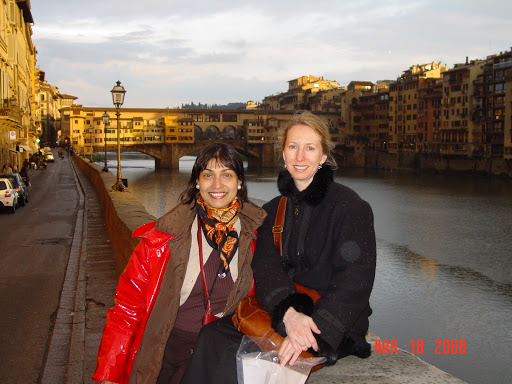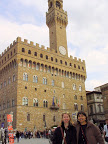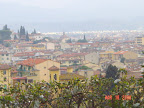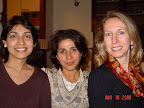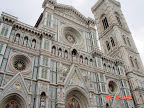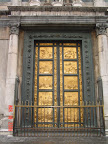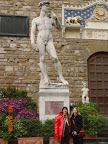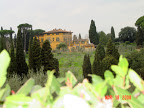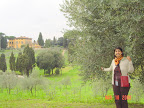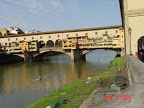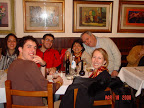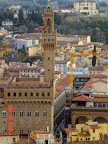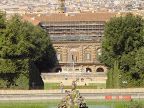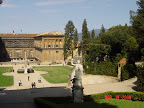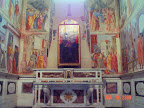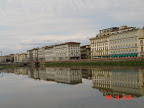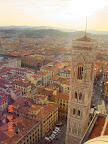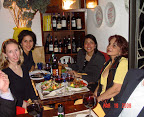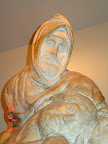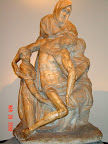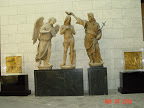Fabulous Florence
(Amy and I pose on the banks of River Arno in Florence with the famous Ponte Vechhio behind us)
What can one say about Florence that hasn’t been said before? What adjective can one find to describe a city that has existed for thousands of years and has barely changed since its most glorious epoch? Florence was a high seat of the Renaissance—the rebirth in the arts and culture, literature and learning that swept through Europe in the late fifteenth and sixteenth centuries resulting in that vast outpouring of intellect and creativity is plainly in evidence on the bricks of its walls, the cobbles of its ancient streets and the breathtaking canvasses and statues that adorn its many museums.
So once in Florence prepare yourself for the best that Europe can offer—uniform red-roofed structures (left) punctuated by cloud-piercing bell-towers, roomy piazzas surrounded by stolid official buildings, fashionable shops selling luxury items such as leather goods and olive-wood writing implements, unusual paper products and glass jewelry in the distinctive mille fiori, pietra dura and mosaic patterns, cloistered churches within whose walls lurk world-famous frescoes, expensive restaurants that serve some of the best ciocolata caldo (hot chocolate) in the world and old-world bridges upon which goldsmiths still continue to display their craftsmanship just as they did in the prosperous days of the Medici dukes.
I had last visited Florence twenty years ago and very briefly at that! In fact, as I check the entries made in my travel journal at the time, I see that I had passed through the city with my French friend Chantal for just a day–at which time we had breezed through the Uffizi, stolled through the Piazza della Signoria and the Palazzo Vecchio (left) to see the fake sculpture of David by Michelangelo, saw the Duomo, the Baptistry and the Campanile from the outside, crossed the Ponte Vecchio, walked through the Boboli Gardens and visited the Church of Santa Maria Novella—all in one day. It was just a brief walking tour of the city’s most touristic spots. Unbelievable! I can’t imagine how I managed to tear myself away from this city so quickly.
Twenty years later, I was determined that things would be very different for Amy and me. She too had visited Florence before but now that we were older, much more mature, far better educated in Art History and so much less frugal, we could look forward to a better time. We intended to take Florence at a far more leisurely pace, to savor its unique ambience and to integrate ourselves into its Medieval and Renaissance history.
At Home with a Friend:
Walking just five minutes from the train station to Via Sant Antonio, we arrived at the lovely fourth floor walk-up apartment of my NYU friend and colleague, Dr. Mahnaz Yousefzadeh (center) who is currently on a teaching assignment at NYU’s campus at Villa La Pietra. Mahnaz welcomed us warmly and chatting over a glass of wine and sugar-sweet clementines, we spent a relaxing evening. Because Mahnaz had an official dinner appointment that evening, she directed us to Trattoria Za-Za located close to the Church of San Lorenzo for dinner. Amy and I loved the basement dining room with its stucco walls and the intimate corner to which our waiter directed us. Over a lovely carafe of vino rosso (red wine), we tucked into Italy’s most popular appetizer—crusty bread dipped in extra virgin olive oil and balsamic vinegar (olio e aceto balsamico). We decided to try the pasta and with Amy opting for penne pomodoro while I chose a ravioli stuffed with spinach and goat cheese in a walnut sauce, we had ourselves one of the most memorable meals in Italy.
Unable to call it a day, we took a detour on the way home and arrived, startlingly, at the Piazza delle Duomo (left) where we were accosted by the magnificence of Florence’s most revered structures—the 11th century Baptistry in which Florentines like Petrarch, Dante and Machiavelli were once baptized, the Campanile or bell tower and Duomo dei Santa Maria del Fiore which is topped by the amazing engineering of Brunnelleschi’s Dome. To behold it in the moonlight while the softness of its marble exterior glowed was truly magical and we were both speechless. Having seen these monuments before, I too was struck by the impact they made upon me in their new spotless avatars. Indeed every single one of these buildings has been cleaned and restored. Now we know what the Europeans are doing with the money generated by their thriving economies!
Outside the Baptistry, Lorenzo Ghiberti’s famous “Gates of Paradise”, (left) also recently refurbished, gleamed in the light of the full moon. Named thus by Michelangelo who was deeply impressed by them, the name stuck and, generations later, we still know them by this appendage. How fortunate we felt to have these monuments to ourselves, stripped of the throngs of tourists who normally choke the squares to capacity! Unable to tear ourselves from these sights, we walked all around the Duomo taking in its various curves and angles and noticing the difference in the appearance of those few portions of the church where restoration is still in progress.
Exploring the Uffizi Gallery:
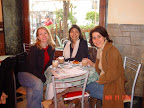 The next morning, Mahnaaz, Amy and I gathered in the Café del Rossa for a caffe latte and a chocolate brioche in what became one of our daily morning rituals (left). We learned from Mahnaz that food consumed at the counter in restaurants or trattorias cost a fraction of their price when eaten at a table! That explains why so many office-bound Florentinos crowded around the counter while munching their brioches and sipping their cappucinos.
The next morning, Mahnaaz, Amy and I gathered in the Café del Rossa for a caffe latte and a chocolate brioche in what became one of our daily morning rituals (left). We learned from Mahnaz that food consumed at the counter in restaurants or trattorias cost a fraction of their price when eaten at a table! That explains why so many office-bound Florentinos crowded around the counter while munching their brioches and sipping their cappucinos.
When well braced against the rigors of the day’s sightseeing, we bid Mahnaz goodbye and set off for the Uffizi Gallery where I had made online bookings several weeks in advance. The last time I had been to the Uffizi, we had spent an hour and a half in line just waiting to get in. I was determined not to let this happen anywhere and paying the extra 3 Euros that it took to make online reservations, we walked right up to the counter, past the waiting crowds, claimed our tickets and walked straight into the Museum.
The Uffizi is one of Europe’s greatest art galleries and the museum whose collection numbers canvasses in the thousands, is able to display only a small fraction of those at any given time. After a huffing and puffing climb that took us to the third floor of the museum, we began our exploration of its highlights using Marina Vaizey’s 100 Masterpieces of Art as well as the recommendations contained in Lonely Planet Italy and the DK Eye Witness Travel Guides. And so we saw them all—the heavyweights of Renaissance Paintings—from Botticelli’s Birth of Venus and Allegory of Spring to Michelangelo’s only oil painting–his portrait of the Holy Family; from Pierro della Francesca’s portraits of the Duke and Duchess of Urbino to Fra Lippo Lippi’s Madonna and Child; from Giotto’s Madonna to Gentille da Fabriano’s glorious Adoration of the Magi. My very favorite painting in the Uffizi, however, Carravaggio’s Bacchus, I saved for the very last, finding it tucked away on the lowest floor in a special exhibition. We found our art notes most helpful in understanding the history and techniques of these canvasses and had no idea where the time flew as we moved from one room to the next within the vast spaces of the museum, stopping only to take in the fabulous views of the Arno flowing down below us from the topmost floor.
Then, we were out on Piazza della Signoria (left) joining the hordes of tourists who had arrived by mid-day to mill around taking pictures. One of the best ways to enjoy these popular cities of Europe is to wake at the crack of dawn and get to the monuments before the rest of the visitors invade or to wait until night fall to see the monuments in a completely different light. Making our way slowly towards Santa Maria Novella railway Station, we boarded Bus number 12 that took us to our next destination in about twenty minutes.
Viewing Villa La Pietra:
The complex that is known as Villa La Pietra (left) consists of five Florentine villas spread out on a property of 500 acres that belonged to the aristocratic English family of the Actons. Lord Harold Acton, last owner of the estate, having been childless, passed it on to New York University which converted the property into an international campus and has been leading a very successful program in Florence for the past 15 years. While four villas today house classrooms, dorms and other administrative offices, Villa La Pietra itself, the house in which the Actons lived, has been retained as a museum to showcase the vast collection of art and antiques that the Actons acquired in their lifetime. After a lasagne lunch in the campus cafeteria, Amy and I took the guided tour of the home and gardens that was conducted by one of the students. As we toured the reception rooms and the private rooms of the Actons, our eyes took in the full range of sculpture, paintings and decorative objects d’art that Lord Acton loved. However, it was the gardens that were truly spectacular. When NYU took over the property, they undertook a fourteen year plan for the development of the gardens and in the thirteen years that have ensued, they have done an amazing job.
To walk through the extensive olive groves, the formal Italianate gardens full of statuary (there are more than a hundred pieces of sculpture in the gardens), the yew and box borders, is to be transported into Paradise. Divided into various rooms, each part of the gardens revealed themselves to us in a different guise. And at the very bottom of the garden were the grand sweeping vistas that presented the rooftops of Florence in all their varied glory. Truly, the tour of Villa La Pietra gave us a glimpse into the kind of palazzos in which moneyed Italians have lived for generations and we felt privileged to have had the opportunity to peak into this wealthy lifestyle.
Around Piazza della Republica:
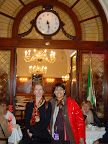 By the time we returned on the bus to Piazza della Republica, we were ready for a hot chocolate and having one at the famous Ristorante Gilli (left) that is situated right on the square and has been made internationally known by the films of Merchant-Ivory was high on our priority list of things to do. We settled down to steaming cups of what seemed like liquid candy—it was so dark, so sweet and so astonishingly thick we could stand our spoons in it. At 6 Euros a cup, it was steeply priced, but easily one of the most memorable cups of hot chocolate we had ever tasted. With this sweet sustenance, our thoughts turned to dinner and we decided to stroll to Via Il Pacheti to make reservations at Ristorante Il Latini that is highly recommended as offering some of the finest meals in Florence for a very reasonable tab. When we did find the place on a winding, nondescript street, we were told that no reservations were taken. However, we were promised a table at 7.30 pm and we resolved to get back to the restaurant well in time to claim our seats.
By the time we returned on the bus to Piazza della Republica, we were ready for a hot chocolate and having one at the famous Ristorante Gilli (left) that is situated right on the square and has been made internationally known by the films of Merchant-Ivory was high on our priority list of things to do. We settled down to steaming cups of what seemed like liquid candy—it was so dark, so sweet and so astonishingly thick we could stand our spoons in it. At 6 Euros a cup, it was steeply priced, but easily one of the most memorable cups of hot chocolate we had ever tasted. With this sweet sustenance, our thoughts turned to dinner and we decided to stroll to Via Il Pacheti to make reservations at Ristorante Il Latini that is highly recommended as offering some of the finest meals in Florence for a very reasonable tab. When we did find the place on a winding, nondescript street, we were told that no reservations were taken. However, we were promised a table at 7.30 pm and we resolved to get back to the restaurant well in time to claim our seats.
With more than an hour left to kill, we wandered towards the Arno and on impulse decided to cross the Ponte Vechhio (left) to sample the wares of some of the smartest shops in the city. But, en route, I was enticed by the display windows of Il Papyri, a chain store that specializes in fine writing implements and unusual paper. I decided to try to find a special gift for Llew who loves fountain pens and uses them regularly. In the company of the sweetest saleswoman, both Amy and I ended up buying olive-wood fountain pens with bottles of old-fashioned ink, sticks of sealing lacquer and a seal with the initial A on it to be used for sealing letters in the Renaissance style. With our goodies beautifully wrapped up in the Italian custom, we headed towards the Ponte Vechhio and spent the most delightful time peering at the dazzling jewels displayed in the windows of the city’s foremost jewelers. When we arrived on the opposite bank of the River Arno—the Oltrarno, as it is known, we decided to walk on the other side of the bridge to continue window-shopping.
A little while later, we were seated at Il Latini (left) which had attracted a long queue outside its doors. Once we made it into the restaurant, we were placed at a long communal table, coincidentally enough, with a group of young American students visiting Italy on their spring break. Even before we had a chance to glance at the menu, the proprietor who took a shine to Amy (blame her blonde good looks!), brought us plates of antipasto that consisted of the most succulent proscuitto (which hung from great big hooks in the ceiling beams), Genoa salami and crostini slathered with liver pate and bruschetta. Having almost made a meal of the appetizers and crusty bread that followed, Amy and I decided to share the House Pasta—a Penne alla Latini which came with a tasty meat sauce. We polished it off in minutes, then decided to sample the desserts and settled for a panna cotta which was amazingly light. The proprietor then decided to send us complimentary glasses of muscadet (a sweet dessert wine), and another tiny glass filled with vino santo which was accompanied by tiny almond biscotti. After all the red wine we had drunk with our meal, this seemed almost sinful but we relished each drop and was stunned when our bill came to just 15 Euros each.
When we returned to Mahnaz’s apartment, I found that my colleague Minu Tharoor had arrived from New York that morning and after a noisy reunion with her, we sat down to chat late into the night before sheer fatigue made us call it a night.
Excursion to the Barghello:
When we awoke the next morning, we resumed our morning breakfast ritual at the café before heading off to the Barghello Museum (left) to see its marvelous collection of sculpture. While almost everyone is familiar with Michelangelo’s David, few people know Donatello’s David and it was primarily to see this sculpture that I had made online reservations at the Barghello which used to be a prison in the Middle Ages.
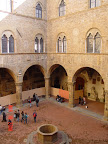 It chilled me to realize that the torture and execution of prisoners took place in its central walled courtyard (left) through which we passed. The building is itself a curiosity with its stark brick lined walls and the tower that rises upwards to become a city landmark.
It chilled me to realize that the torture and execution of prisoners took place in its central walled courtyard (left) through which we passed. The building is itself a curiosity with its stark brick lined walls and the tower that rises upwards to become a city landmark.
We started our discovery of this collection of outstanding sculpture on the ground floor with iur examination of Michelangelo’s superlative work including his Bacchus, Brutus and the circular, unfinished Madonna and Child. But it was Giambologna’s Baccho that was the most strikingly beautiful item in this room carved, as it was, in stunning dark marble. With this room covered, we climbed the stairs to get to the first floor where I discovered to my disappointment that Donatello’s David was being restored and was laid down on its back allowing us to see some aspects of the sculpture that would otherwise have remained hidden. Despite the odd position in which we found David, I was so deeply moved by the sculpture that I found my eyes tearing up. Donatello’s young androgynous David, about whom so much has been written, was much smaller than I expected and yet so graceful in its portrayal. We also saw the originally submitted panels for the competition that had Ghiberti and Brunnelleschi battle out for the commission of the Gates of Paradise. Overall, visiting the Barghello was a deeply fulfilling experience and I heartily recommend that more visitors place it on their itinerary.
Perusing The Pitti Palace and the Boboli Gardens:
Then it was time for us to troop off to the Pitti Palace (left) where we had reservations for 11.30 am. Over the Ponte Vecchio and in the Oltrarno, once again, we found ourselves outside the squat and very plain building that, in a huge trick of deception, houses some of the most opulent rooms in all of Europe. Once we bought our tickets (rather steep at 12 Euros plus 10 Euros for a visit to the Boboli Gardens), we were swept away into the grandeur of the Medici Royal Apartments where the elaboration of the decoration simply beggars description, so I will not even try to describe it. Suffice it to say that layer upon layer of decorative elements—sculpture, painting, gilding, fresco, and bas relief accompanied by the bright lights of colossal crystal chandeliers combined to give the rooms a sense of splendor that was meant to impress visiting heads of state and royalty that, over the centuries, arrived in Florence to partake of its legendary finery.
It was almost a relief to leave the palace rooms behind to wander into the art gallery which housed some of the most famous paintings and sculpture in the world including a number of truly elegant Madonnas by Raphael, Fra Lippo Lippi’s exquisite Madonna and Child and several works by Titian. I particularly loved Antonio Canova’s sculpture of Venus de Milo but had to rush from one room to the next to take in the vast collection of silver, ivory, porcelain, glassware, jewelry, amber, etc. that the Medici collection could boast. Both Amy and I who have a fondness for everything beautiful from jewelry to ivory boxes were truly enchanted by this collection and agreed that this was the first time on our trip that we felt truly overwhelmed for we could easily have spent a whole day in the palace.
Tired, and deciding to give sightseeing a break, Amy wandered out to the front lawns of the Palace to people-watch while I explored the famous Boboli Gardens (left) at the back of the building. I was keen to photograph the gardens for my website but must admit that there was really very little that was truly picture-worthy. Spring foliage hadn’t yet arrived and most trees were bare. While a few visitors lazed on the lawns and sunbathed on the terraces of the formally landscaped tiers, I took pictures of the many urns and statues that dotted the pools including the attractive one of Neptune in the center of the garden.
The Capella Brancacci:
Then, joining Amy on the street outside, we rambled on through the lesser-known squares of the Oltrarno before we arrived at Piazza del Carmine which houses the church called Santa Maria del Carmine where we hoped to be able to enter the famous Capella Brancacci (left). This renowned venue hides one of the most amazing cycle of frescoes in the world—a series that was started by artist Masaccio but was taken on by Massolino and finally completed by Fra Filipinno Lippi. While Masaccio’s work presents scenes from Genesis—his agonized Adam and Eve Expelled from Paradise is truly heart-breaking and Massolino depicted the Temptation of Adam on an opposite wall, scenes from the life of St. Peter were the focus of Lippi. Begun in 1425, they were finally completed in 1480 and were the envy of artists such as Leonardo and Michelangelo who visited the chapel to study this work. Since entry into the chapel is very closely limited to just 30 people at a time and since visits are strictly by appointment which we had failed to make, we felt extremely fortunate to sneak in with a student group. After we had studied and admired the frescoes, we spent some time in the cloistered courtyard of the chapel which I found exceedingly enchanting.
Florence’s Other Temptations:
Before leaving the Oltrarno, I resolved to try and find the Gelateria del Carriaia which my students Jessica and Kristin had told me served the best gelato in the city. And they were entirely correct. Trekking through the tangle of narrow city streets, with the aid of a map, we did find the location right at the very corner of Ponte de Carriaia and for the next several minutes, as we poised ourselves on the wide ledges overlooking the banks of the River Arno with our ice-cream, we enjoyed gazing at the reflections of the buildings in the water (above left). Then, we were crossing Ponte de Trinita on foot to try to find the Church of Santa Trinita and the Ghirlandaios contained within that Minu had told us we simply must not miss. Alas, the church was closed for the afternoon siesta and we made our way instead back to the Piazza della Signoria with the aim of touring the interior of the Duomo de Santa Maria de Fiori.
Trekking up into the Heights of Brunnelleschi’s Dome:
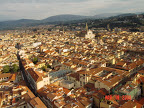 Amy was in the midst of reading Brunnelleschi’s Dome by Ross King and was able to provide me with the inside scoop on the construction of the Dome. We did enter the church and took in the stark and rather dark interior and then decided to pay the 6 Euros to climb up the 468 steps to the cupola of the Dome in order to treat ourselves to unforgettable views of the rooftops of Florence.
Amy was in the midst of reading Brunnelleschi’s Dome by Ross King and was able to provide me with the inside scoop on the construction of the Dome. We did enter the church and took in the stark and rather dark interior and then decided to pay the 6 Euros to climb up the 468 steps to the cupola of the Dome in order to treat ourselves to unforgettable views of the rooftops of Florence.
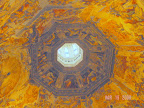 What an amazing experience that was! I did not think that either one of us would have the energy for so strenuous a climb after the incessant amount of walking we had done for the past week. But somewhere we found the fonts of energy that propelled us to the top, allowing us to see the immense interior of the dome with the superb painting of The Last Judgment by Giorgio Vassari (Brunnelleschi’s biographer) at such close quarters that I felt as if I could reach out and touch it. Having taken our time to get to the top, we reached there at dusk and gasped at the vistas that were spread out before us. How fabulous it was to be able to pick out the various landmarks of the city with which we had become fondly acquainted in the past couple of days!
What an amazing experience that was! I did not think that either one of us would have the energy for so strenuous a climb after the incessant amount of walking we had done for the past week. But somewhere we found the fonts of energy that propelled us to the top, allowing us to see the immense interior of the dome with the superb painting of The Last Judgment by Giorgio Vassari (Brunnelleschi’s biographer) at such close quarters that I felt as if I could reach out and touch it. Having taken our time to get to the top, we reached there at dusk and gasped at the vistas that were spread out before us. How fabulous it was to be able to pick out the various landmarks of the city with which we had become fondly acquainted in the past couple of days!
There was the Pallazzo Pitti and there was San Lorenzo and there in the distance was Santa Croce.
Meanwhile, right before us, the Campanile stood like a sentinel, its marble pietra dura inlay thrilling us in the many soft shades of green and pink and peach that were imbedded in the white stone column. And to see Brunnelleschi’s work up close and personal—what a treat that was! Words cannot describe the impact that this view of the world had on me. I could not stop clicking and when I had quite finished taking pictures, I wanted to sit quietly and watch the sun set over a salmon Florentine sky as lights came on in the distance.
You can see me at left gazing in awe at a sculpture of Filipo Brunnelleschi, architect of the Dome as he gazes up at his own handiwork. I thought that the placement of this sculpture in the Piazza of the Duomo was indeed ingenious. Climbing almost 500 steps to see his work at such close quarters was truly one of the highlights of our tip and I know I will never forget the trek to the top that brought us this wonderful perspective on Italy
Dining and Breakfasting out in Florentine Style:
That evening, Minu and Mahnaz joined us for dinner. Since it was Persian Nourooz (New Year), Mahnaz wanted to celebrate and we decided to treat our hostess to a slap up dinner at a place she suggested—Ristorante Acqua Al Due—where the food was seriously good (left). Over excellent house Chianti, we shared a salad and a Fussilli in Spinach Sauce—both of which were wonderful. As each of us ordered different entrees, I settled for Veal in a Porcini Sauce—a simply amazing dish that was tender and tasty—and split Tiramisu and a Fruit Tart for dessert—all of which cost us about 22 Euros per head. Since it happened to be pouring during the time we were indoors, we walked out into a wet and chilly evening but could not resist stopping once more at Piazza del Duomo to see the church’s dominant edifice once again by moonlight.
The Accademia della Arte and Our Discovery of David:
To our relief, sunlight streamed in through the window, waking us the next morning to our breakfast of caffe latte and chocolate croissants at our corner café. I was very excited as we had reservations that morning to get to the Academia delle Arte (the Academy of Fine Arts) which houses Florence’s most famous sculpture—Michelangelo’s David. However, the weather changed suddenly and by the time we reached the Academia, merely ten minutes later, it was rainy and cold. What a relief it was to escape into the museum before the majority of the tourist crowd arrived in our wake.
At the entrance, we were quite taken by Giambologna’s towering sculpture of The Rape of the Sabines. The work is encircled by some of the most famous of the gallery’s collection including oil paintings by Botticelli and Ghirlandaio. However, it was a magnificent panel that once decorated a Tuscan dowry chest known as the Cassonne Adimari by Lo Scheggia that caught Amy’s eye and had her in a thrall as it featured the wedding ceremony of the influential Adimari family.
Making our way into the next room, we went past Michelangelo’s Four Prisoners, so-called because these unfinished works by the master seem to represent an attempt on their part to escape from the entrapment of their stone prisons. However, I do believe that few visitors give these works the attention they deserve as our eyes are drawn as if by voodoo to the compelling sculpture of David at the far end of the hallway where he towers above the crowd like a colossus on a lofty pedestal. Once again, I find myself groping for words to describe the impact that this work had on me. Though I had seen many copies of Michelangelo’s most famous work over the years—in the Piazza della Signoria and outside a planetarium in Glenview, California, many years ago, these copies appear like trash when compared to the real thing. David was, for me at least, truly mesmerizing and I found it hard to believe that anything so huge and so powerfully executed could, at the same time, be so graceful. Amy and I spent more than half an hour encircling this three-dimensional free-standing sculpture and read a lot about its history. We even played with the electronic devices in the room that allowed us to see video images lit up in such a manner as to highlight different angles of the work. In the presence of such greatness, we were dumbfounded. Despite the fact that so many other visitors were present in the room at the same time, you hardly heard a sound. When people spoke, it was almost respectfully, in hushed whispers.
Medieval Florence:
Leaving the Academia behind, we walked towards the furthest reaches of the city center to take in the Convent of San Marco where Fra Angelico’s fresco presenting The Annunciation is considered one of the world’s masterpieces of art. This permitted us the opportunity to stroll through one of the most unspoiled piazzas in Florence. Indeed, were it not for the fact that buses plied to neighboring towns in the next street, we could easily have believed that we had regressed to the 13th century. Brunnelleschi’s Spedale degli Innocenti (Orphanage for Abandoned Mites) dominated this square decorated on its facade by the ceramic figures of babies by Lucca della Robbia. This building was an orphanage in Renaissance times and allowed women to leave foundlings on its doorstep.
Just adjacent to this structure is one of Florence’s most ornate Baroque churches—the Santissima Annunziata–though you wouldn’t know it by the modesty of its exterior. Once inside the church, however, the eye was exhausted by the wealth of decorative detail.
The Museum of Santa Maria del Fiore:
Our next port of call was the Museo del Duomo de Santa Maria del Fiori, a lovely space that holds all of the original sculptural figures that once adorned the façade of the Duomo.
Today, the figures one sees on the front of the church are copies that brave the elements. The original ones, sculpted by such masters as Donatello and Lucca del Robbia (not to be confused with Andrea della Robbia who created the famous ceramic wreaths) are housed inside the museum in an attempt to preserve them for posterity. The museum also contains Donatello’s stirring wooden Mary Magdalen, which, leaving all the conventions of Renaissance style behind it, is executed in an extremely futuristic fashion. Mary Magdalen looks deeply tormented in this portrayal.
One of the most striking items in this collection, however, is Michelangelo’s early limestone Pieta (the one in St. Peter’s Basilica in Rome in marble is by far the more famous one) featuring Nicodemus as the central character as he takes Christ down from the cross. What is fascinating about this sculpture is that the face of Nicodemus is a self-portrait of Michelangelo and, therefore, a superb likeness of this Renaissance master
Downstairs in the walled courtyard are the original bronzed ‘Gates of Paradise’ by Ghiberti (gleaming in their recently refurbished state) and the original three sculptures of Jesus, John the Baptist and the Angel –copies of which stand today above the Baptistry Gates.
Then, just by chance, we discovered that Bus Number 7 ran right by the next square and we decided to board it in order to leave the bustle of Florence behind and escape into the Tuscan countryside. A few minutes later, we found our bus climbing up the steep wooded hillsides towards Fiesole, one of the prettiest little villages in the Florentine vicinity.
(To Follow Amy and me on our excursion to Fiesole, please click on the link. You can return to our sightseeing in Florence at the end of the page on Fiesole.)
More Florentine Adventures:
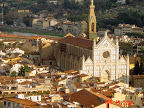 Since it was Maundy Thursday, I decided to try and find out if I could catch an evening service in one of the city’s many historic churches. Because we had not yet visited the Church of Santa Croce (left), we alighted at Piazza San Marco and walked (with the aid of a map) towards the church. As evening had fallen by then, the church was closed to visitors as worshippers made their way inside for the 6pm service. Just before the service began, however, I was fortunate enough to tour the interior where I saw the stirring monuments and tombs of such beloved Florentines as Michelangelo, Dante, Macchiavelli, and Galileo. These finely sculpted marble monuments are works of art in themselves but the fact that they are located within a historic church gives them a unique sanctity. Then, I made my way along the cloistered courtyard towards the Capella de Pazzi where I was one of the last visitors of the day to see Brunnelleschi’s tiny chapel designed by the master architect and decorated with ceramic motifs by Lucca della Robbia. Though it appears rather stark and devoid of ornamentation, it is considered a fine lesson in the principles of Renaissance architectural design.
Since it was Maundy Thursday, I decided to try and find out if I could catch an evening service in one of the city’s many historic churches. Because we had not yet visited the Church of Santa Croce (left), we alighted at Piazza San Marco and walked (with the aid of a map) towards the church. As evening had fallen by then, the church was closed to visitors as worshippers made their way inside for the 6pm service. Just before the service began, however, I was fortunate enough to tour the interior where I saw the stirring monuments and tombs of such beloved Florentines as Michelangelo, Dante, Macchiavelli, and Galileo. These finely sculpted marble monuments are works of art in themselves but the fact that they are located within a historic church gives them a unique sanctity. Then, I made my way along the cloistered courtyard towards the Capella de Pazzi where I was one of the last visitors of the day to see Brunnelleschi’s tiny chapel designed by the master architect and decorated with ceramic motifs by Lucca della Robbia. Though it appears rather stark and devoid of ornamentation, it is considered a fine lesson in the principles of Renaissance architectural design.
Meanwhile, a short path led towards the Capella Baroncelli that is covered with frescos by Tadeo Gaddi, Giotto’s famous pupil. Many amazing art works are housed in this chapel today following the flood of 1966 which damaged valuable works including Cimabue’s Crucifix.
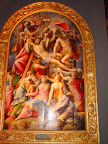 Lorenzo Veneziano’s Deposition from the Cross (left) was particularly striking both in its dimensions and the quality of its execution. Meanwhile, the tiny Capella Bardi which contains Giotto’s frescoes depicting the life and death of St. Francis are enclosed within a tiny space and could easily be seen even as I attended the short evening service in Italian and received Communion.
Lorenzo Veneziano’s Deposition from the Cross (left) was particularly striking both in its dimensions and the quality of its execution. Meanwhile, the tiny Capella Bardi which contains Giotto’s frescoes depicting the life and death of St. Francis are enclosed within a tiny space and could easily be seen even as I attended the short evening service in Italian and received Communion.
This, being our last night in Florence, I decided for dinner to try the famous regional specialty called Bistecca alla Fiorentina which is simply steak grilled very rare and served with no seasonings. As Amy was frightfully cold that evening, we started our meal in a tiny trattoria—so tiny that I cannot remember its name and will never find it again—where we ate wonderfully warming faro (barley) soup and a chicken broth with bread lurking in the bottom. When the bistecca did come to our tables, we split it and found it very satisfying indeed. The English trifle was not such a great choice, however, and, with Amy all warmed up, we decided to go out in search of some good gelato for dessert.
It was with relief that we dropped into bed that night after massaging the balls of our aching feet. It was our last night in Florence and I had truly enjoyed every remote nook and cranny of this medieval city and could gladly have spent another week there. Though it is crammed full of treasures, it is a city that can easily be discovered entirely by foot and if walking is one of your pleasures as it is mine, you will find a lot to charm in this European gem.
Michelangelo’s Marvels in San Lorenzo:
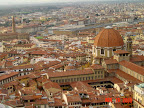 Awaking the next morning to another lovely day, I decided to try and catch a glimpse of the Blessed Sacrament in the Church of San Lorenzo as it was Good Friday and our train to Naples did not leave until 11 am. Mahnaz’s apartment is located on a small street right off the piazza that holds the massive domed church and we had spent a great deal of time lingering among the many stalls set up by immigrant vendors from Iran and Africa as we surveyed their leather goods, silk scarves and souvenirs.
Awaking the next morning to another lovely day, I decided to try and catch a glimpse of the Blessed Sacrament in the Church of San Lorenzo as it was Good Friday and our train to Naples did not leave until 11 am. Mahnaz’s apartment is located on a small street right off the piazza that holds the massive domed church and we had spent a great deal of time lingering among the many stalls set up by immigrant vendors from Iran and Africa as we surveyed their leather goods, silk scarves and souvenirs.
However, we had never been inside the church. That morning, visitors trooped in solemn mood to pray in the church on this holiest of days in the Christian calendar. I was struck by the works of art inside, the most amazing of which was the Martyrdom of St. Lawrence (for whom the church is named) by Bronzino—a massive fresco on the east wall that depicts the human form is so many different poses even as it presents the agony of the saint while being roasted on live coals. Right behind us, the bronze pulpits by Donatello—not refurbished and, therefore, pitch black—depicted Christ’s Passion and Resurrection.
Then, we walked behind the exquisite pietra dura altar, also surrounded by Old Master paintings, in front of the simple grave stone marking the final resting place of Cosimo I (Il Vecchio) to arrive at the Medici Chapel where the Blessed Sacrament was exposed. Despite the fact that the chapel is undergoing extensive renovation and was almost entirely concealed behind metal scaffolding, we could see the six marble tombs of the Medici princes as well as the gorgeous altar that was thickly decorated with flowers for the coming Easter Sunday services. The entire chapel is visually stunning as massive marble pillars and walls are studded with pietra dura decoration featuring every color and variety of native Italian stone. Then, I was rushing around towards the cloisters to climb up the steps to the first floor Medici Library whose sweeping staircase was designed in Mannerist style by Michelangelo as was the private family Library within. The Capella Medici’s New Sacristy also contains two interesting tombs by Michelangelo —one of The Dukes of Nemours and the second of The Duke of Urbino (grandson of Lorenzo the Magnificent). Lorenzo’s own tomb, with that of his murdered brother Giuliano, is close by.
I was very pleased indeed to have seen this extraordinarily important church and having already seen the Church of Santa Maria Novella, twenty years ago, I ended up seeing every single one of the most important churches that dot the Florentine map.
Racing back to Mahnaz’s place to pick up our bags, we walked briskly to the nearby station to catch our train to Naples where we arrived at 2 pm. after a very interesting journey that took us to Rome where the train made a quick stop.
To follow Amy and me on the next leg of our travels in Naples, Italy, please click on the link below:
Bon Voyage!
